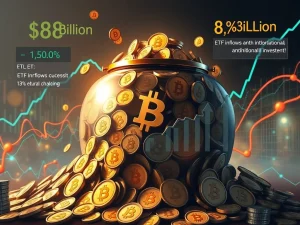Controversial Bitcoin Core Update Raises OP_RETURN Data Limit, Sparks Community Backlash

A significant and controversial change is coming to the Bitcoin blockchain. An upcoming Bitcoin Core update is set to drastically increase the amount of data that can be stored on the network using a specific function, a move that has ignited passionate debate within the community.
What is the OP_RETURN Change in the Bitcoin Core Update?
Bitcoin Core developer Gloria Zhao announced on GitHub that the upcoming Bitcoin Core 30 update, scheduled for October 30, will remove the current 80-byte limit on the OP_RETURN function. This change, part of merged pull request (MPR) #32406, will allow each output using OP_RETURN to carry up to 4 megabytes of data.
The decision follows a statement signed by 31 Bitcoin Core developers on May 5, signaling their support for this modification.
Impact on Bitcoin Data Limit and Ordinals
The Bitcoin data limit increase for OP_RETURN has direct implications for how data is embedded onto the blockchain. This function was notably utilized by the Ordinals protocol, which gained popularity last year.
Ordinals allowed users to inscribe various types of data onto individual satoshis (the smallest unit of Bitcoin), effectively creating NFT-like assets and enabling the storage of images, text, and other documents directly on the blockchain.
With the expanded data capacity via OP_RETURN, the potential for storing larger and more complex data directly on the Bitcoin blockchain increases significantly.
Community Reaction: Debate Over Bitcoin’s Purpose
This change has been met with strong reactions, dividing the Bitcoin community. One segment, often described as conservative, argues that embedding non-financial data constitutes ‘spam’ that clogs the blockchain and distracts from Bitcoin’s primary purpose as peer-to-peer electronic cash or ‘sound money’.
Critics voice concerns about the impact on node operation and network efficiency. For example, Alexander Lin, co-founder of Reforge, called the expansion a ‘terrible mistake’ on X, suggesting it ‘increases systemic risk to btc’s core property as sound money’.
Conversely, proponents, including Peter Todd, the lead author of the proposal, believe increasing the data limit can expand Bitcoin’s potential use cases beyond just financial transactions, fostering innovation and new applications on the network.
Developer Stance and User Autonomy
In the GitHub statement, Gloria Zhao articulated the developers’ position, emphasizing a hands-off approach regarding how users choose to utilize the chain. The statement highlighted that ‘Demanding that Bitcoin Core prevent certain transactions from being mined reflects a misunderstanding of the relationship between open source software users and developers.’
This perspective suggests that the developers see their role as providing the software infrastructure, leaving it to users and miners to decide what transactions are valid or desirable based on network rules and economic incentives.
Faith Broken and Market Share Shifts
The controversial nature of the Bitcoin Core update has led to disillusionment among some long-time community members and supporters.
Dennis Porter, CEO of Satoshi Action Fund, expressed his disappointment, stating his ‘faith in their work is now broken’ and that he would cease supporting Bitcoin Core development financially. Jason Hughes, vice president of Bitcoin mining firm Ocean, indicated fatigue with the ongoing debate, suggesting he might step away from the industry over such issues.
Interestingly, since the proposal (MPR #32406) was introduced in late April, Bitcoin Core’s dominance in the market share of Bitcoin nodes has reportedly declined from approximately 98% to around 88%. Data from coin.dance suggests that the Bitcoin Knots client has gained most of this market share, now sitting at over 11%.
Bitcoin commentator Matthew R. Kratter speculated that this decision could lead to a significant long-term decline in Bitcoin Core’s dominance, potentially falling to the 20-30% range in the coming years as users opt for alternative node implementations that may reflect different philosophical viewpoints.
Conclusion: An Ongoing Debate on Bitcoin’s Future
The decision to raise the OP_RETURN data limit in the upcoming Bitcoin Core update is more than just a technical tweak; it’s a flashpoint in the ongoing debate about the fundamental nature and future direction of the Bitcoin blockchain. While developers advocate for user freedom and expanded use cases, a significant portion of the community fears deviation from its core ‘sound money’ principles and potential network strain.
This controversy highlights the decentralized and sometimes contentious nature of Bitcoin development and governance. The coming months, particularly after the October 30 update, will show how this change impacts network usage, transaction patterns, and the evolving landscape of Bitcoin node implementations, potentially reshaping the network’s cultural and technical trajectory.









